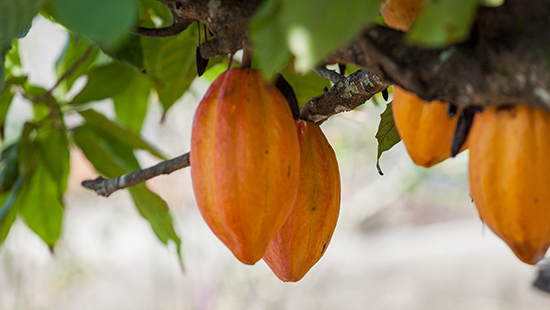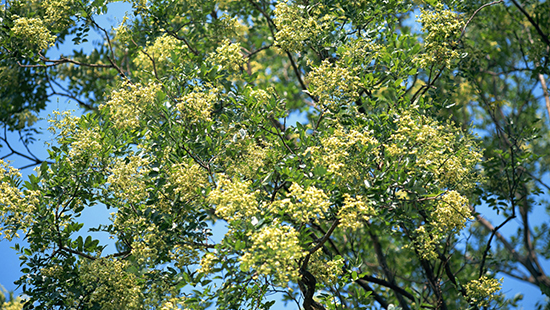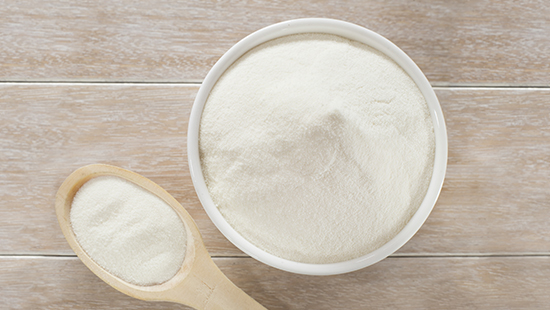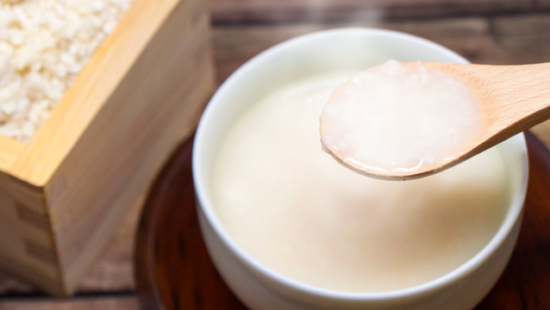1. What is amazake ?
Amazake is a traditional Japanese fermented beverage that has been gaining attention in recent years for its beauty and health benefits. In general, amazake contains sugar, amino acids, vitamin Bs, and many other vitamins, and it is also thought to be rich in biologically active substances, which are fermentation products of yeast and koji mold.
In particular, the main ingredients, sake lees and rice malt, are being studied for their health functions and their functional components are becoming clearer. On the other hand, there have been few reports of health benefits when actually consumed. We have been studying the functions of amazake, such as its beauty effects when consumed.
2. Analysis of ingredients content in amazake
Amazake contains many useful ingredients. We have analyzed the ingredients of each type of amazake.
Ergothioneine (anti-light-aging component), p-coumaric acid (antioxidant component), ferulic acid (UV-absorbing component), and ferulic acid ethyl ester (anti-stress component) were determined by LC-MS or high performance liquid chromatography (HPLC) in 17 commercial products of three types of amazake, "sake lees and rice malt", "sake lees only", and "rice malt only" as the main ingredients.
The results showed that p-coumaric acid and ferulic acid were present in all 17 products.
Ergothioneine was not detected in the "sake lees only" amazake. On the other hand, ferulic acid ethyl ester was found in the amazake containing "sake lees and rice malt" and "sake lees only".
These results indicate that amazake contains a lot of useful components, which vary slightly depending on the manufacturing process.
3. The effect of amazake (sake lees + rice malt) on dark circles under the eyes and the shine of the hair
Seventeen women in their 40s to 60s, who were constipated and concerned about rough skin, were asked to consume two amazake made of sake lees and rice malt twice a day for one month, and their skin was measured.

The results showed improvements in subjective evaluation of "brightness under the eyes", "hair glow", and "improvement in morning awakening" in the amazake group compared to the placebo group.
In addition, an increase in skin brightness and skin surface temperature was observed.
In summary, the consumption of amazake made of sake lees and rice malt was shown to improve dark circles under the eyes, and the results were accompanied by a sense of reality. In addition, the surface temperature of the skin was increased, so it was inferred that the promotion of blood circulation and the excretion of waste products of the skin may have contributed to the improvement of dark circles.
Amazake may have enhanced blood circulation by enhancing the metabolism of nutrients in amazake, and arginine and adenosine may have contributed to the improvement of blood circulation. On the other hand, the subjective improvement in morning wakefulness was considered to be due to the adenosine in amazake, which is known to normalize the sleep-wake cycle. It was speculated that these effects of amazake were the result of the combined contribution of various components, not just a single component in the amazake.
S. Kawakami et. al., FRAGRANCE J. 44(6), 43 (2016)
H. Maruki-Uchida, et. al., Biosci. Biotechnol. Biochem., 84(8), 1689 (2020)
4. Effect of amazake (sake lees + rice malt) on skin sebum
Skin sebum covers the surface of the skin and prevents moisture evaporation, but excessive secretion of sebum can lead to discomfort due to sticky skin, clogged pores, and even skin problems such as acne and blackheads. For women, it can also cause makeup to fall off.
Therefore, the effects of amazake, made from sake lees and rice malt, on sebum were examined in human trials and at the in vitro level.
⟨Clinical Test⟩
Seventeen women in their age 40s to 60s, who were concerned about rough skin, were asked to consume two bottles of amazake made of sake lees and rice malt for one month a day, and their skin sebum levels were measured.

As a result, a decrease of sebum content was observed in the amazake group compared to the placebo group that did not contain amazake.
⟨in vitro⟩
Using sebaceous gland cells, the effect of the sweet sake component, sake lees or rice malt, on the amount of skin sebum was tested.
As a result, the amount of sebum decreased in the groups of dissolved in sake lees and rice malt, and especially in the groups of sake lees and rice malt.
In conclusion, continuous consumption of amazake made from sake lees and rice malt decreased the sebum content of the skin. In addition, the verification of cultured cells suggests that amazake made from sake lees and rice malt may promote the reduction of sebum since both sake lees and rice malt are effective in reducing sebum.
K.Nakagawa et al. 6th International Conference on Food Factors (ICOFF) 2015
5. The effect of ingredients of amazake, rice malt, sake lees and mixture of sake lees and rice malt on skin elasticity and sagging pores
To keep the skin functioning and healthy, it is important to reduce the loss of collagen and other proteins, which make up the skin, and to maintain the viscosity and elasticity of the skin. As the skin loses its elasticity due to aging and ultraviolet rays, the skin's elasticity is defeated by gravity and the pores stretch and sag in a teardrop pattern, making the pores more noticeable. Skin with tighter and more elastic pores affects the appearance of the skin.
Therefore, focusing on the differences in the main ingredients, the cosmetic effects of amazake consumption on skin beauty, especially elasticity and pore shape, were examined in human trials and at the in vitro level.
⟨Clinical Test 1⟩
Forty-six healthy male and female adults in their 30s to 60s consumed one bottle of amazake made of rice malt per day for 8 weeks and had their skin measured.
As a result, the intake of amazake made from rice malt was significantly higher than the intake of placebo, which did not contain amazake, and the changes in the percentage of sagging pores and the amount of change in the perceived pore area were significantly lower.
These results confirmed that consumption of amazake made from rice malt increased skin elasticity and prevented sagging pores.
S. Shimotsuma, et. al., Jpn. Pharmacology and Therapy, 47, 1166 (2019)
⟨Clinical Test 2⟩
Twenty women in their 35-40 years of age, who were constipated and concerned about rough skin, were asked to consume amazake made of sake lees (sake lees) and rice malt for 5 weeks and their skin was measured.
As a result, the intake of amazake containing both sake lees and rice malt significantly increased the elasticity and significantly decreased the change in the rate of sagging pores compared to the placebo group.
These results confirmed that consumption of amazake made from sake lees and rice malt also increased skin elasticity and reduced the rate of sagging pores.
M. Yoshikawa et. al., Jpn Pharmacology and Therapy, 46, 1841 (2018)
⟨in vitro⟩
Using fibroblasts and sebaceous cells, the effects of sake lees and rice malt, the main ingredients of amazake, on collagen gel contraction and collagen-degrading enzymes were examined.
As a result, the group to which dissolved liquor of sake lees raw materials was added (sake lees group), the group to which dissolved liquor of rice malt raw materials was added (rice malt group), and the group to which mixed liquor of both sake lees and rice malt raw materials was added (sake lees/rice malt group) showed significantly higher collagen gel shrinkage than the group to which control without these raw materials was added (control group). It was higher. The contraction rate in the sake lees rice malt group was also higher than the sake lees group and the rice malt group. Furthermore, the collagen degradation activity was significantly inhibited in the rice malt group and the sake lees rice malt group compared to the control group.
H. Inagaki et. al., Jpn Pharmacology and Therapy, 46, 1985 (2018)
These results suggest that consumption of amazake made from rice malt and amazake made from sake lees and rice malt can be expected to have a tightening effect on sagging skin and pores, i.e., to maintain skin elasticity. Furthermore, verification using cultured cells confirmed the mechanism by which sake lees and rice malt, the raw materials of amazake, strengthen the collagen network by increasing the contraction of collagen, which gives the skin its firmness and elasticity, and inhibiting the enzymes that break down collagen, confirming the results of the human study.
6. Improvement of bowel movements by amazake (sake lees and rice malt)
Thirty-eight adult women with mild constipation who were prescribed magnesium oxide were asked to consume one bottle of amazake, made from both sake lees and rice malt, per day for one month to evaluate its effect on bowel movements.


The results showed that consumption of amazake made of sake lees and rice malt improved the number of bowel movements per day, the amount of bowel movements, the condition of the stool and the sensation after bowel movements.
S. Mori et. al., Jpn Pharmacology and Therapy, 47, 759 (2019)
7. Improvement of the intestinal environment by amazake (sake lees + rice malt)
In our intestines, hundreds to thousands of different types of intestinal bacteria, more than hundreds of trillions of them, live in balance with each other to form small aggregates of "intestinal flora". There are three major types of intestinal bacteria: good bacteria that have a positive effect on our bodies, bad bacteria that produce toxins and things that are harmful to our bodies, and opportunistic bacteria that side with the stronger forces.
Good bacteria work by inhibiting the growth of bad bacteria, defending against pathogens and other infections, regulating the immune system, and helping with digestion and absorption.
Good bacteria include yeast bacteria, bifidobacterium, A. oryzae, and Bacillus subtilis var. natto. Lactobacillus is a generic term for bacteria that decompose sugar and produce lactic acid, so there are many types.
In this study, we examined the effects on intestinal bacteria of consumption of sake lees and rice malt, the main ingredients of amazake, a fermented food.
The mice were fed a diet containing sake lees and rice malt, the main ingredients of amazake, for 4 weeks, and the intestinal microflora in their feces were measured.
As a result, the percentage of Lactobacillus increased in the group fed the test diet containing sake lees and rice malt compared to the control group fed the diet containing neither sake lees nor rice malt.
Previous studies have also confirmed an increase in the amount of mucin, which has a barrier function, by simultaneous consumption of sake lees and rice malt, suggesting that sweet sake made from sake lees and rice malt has the potential to promote the growth of lactic acid bacteria in the intestines and improve the intestinal environment.

S. Kawakami et. al., Nutrients. 12(2), pil:E449 (2020)
8. Improvement of the intestinal barrier function by amazake (sake lees + rice malt)
The intestinal tract, including the small intestine, absorbs nutrients while eliminating harmful bacteria and toxins. Therefore, the intestinal tract is covered with a mucous membrane containing mucin, a mucus component, which protects cells and tissues from pathogens and toxins.
In addition to mucin, which physically protects the intestinal tract as mucus, the intestinal tract also has a factor called lgA, which exerts antibacterial activity through an antibody reaction, and the intestinal tract is protected by these "intestinal barrier" functions.
In this study, we examined the effects of consumption of sake lees and rice malt, the main ingredients of amazake, on the intestinal barrier function.
Mice were fed a diet containing sake lees and rice malt for 4 weeks and the amount of mucin in feces was measured.
As a result, an increase in mucin in feces was observed in the test food group fed a diet containing sake lees and rice malt compared to the control group fed a diet containing no sake lees and rice malt.

In addition, mucin-related genes were identified by PCR method, and mucin production was promoted in the test food groups containing sake lees and rice malt, which is thought to be the mechanism of the increase in mucin in feces.
These results suggest that consumption of sake lees and rice malt, the main ingredients of amazake, increases the amount of mucin, which protects the intestinal tract, and increases the expression of mucin-related genes, and contributes to the improvement of the intestinal barrier function that protects the mucous membrane of the gastrointestinal tract from pathogens and toxins.
S. Kawakami et al., 21th Japan Society of Food Factor (2016)
9. Function of amazake (sake lees + rice malt) in innate immunity
Immunity is an important part of human health. There are two major types of immunity: innate immunity and acquired immunity. Innate immunity is an innate immune response that rapidly eliminates pathogens such as viruses and bacteria from entering the body. On the other hand, acquired immunity is an acquired immune response that produces antibodies to pathogens that have escaped from innate immunity and eliminates them.
Silkworms are ideal for assessing innate immunity because they do not have acquired immunity and are dependent on innate immunity. Despite its appearance, silkworm resembles humans, with organs and tissues equivalent to the main organs in humans. Therefore, the acquisition of natural immunity by sake lees and rice malt, the main ingredients of amazake, was verified by using the silkworm evaluation system of Genome & Pharmaceutical Research Institute Co.
Silkworm is ideal for evaluating innate immunity because it has no acquired immunity and relies on innate immunity. Silkworm is also equipped with organs and tissues corresponding to the major organs in humans. Therefore, the acquisition of innate immunity by sake lees and rice malt, the main ingredients of amazake, was verified by using the silkworm evaluation system of Genome & Pharmaceutical Research Institute Co.
Silkworm was administered a mixed preparation of sake lees and rice malt, and the activation of natural immunity was measured by the degree of muscle contraction.

As a result, the intake group of the mixed preparation of sake kasu and rice malt was three times higher than the intake group of green tea extract.
These results suggest that consumption of sake kasu and rice malt, the main ingredients of amazake, activates the natural immune function. Amazake has been attracting attention for its health effects, and has been called "drip infusion to drink" because of its high nutritional value.
H. Maruki-Uchida et. al., Drug. Discov. Ther. 11(5), 288 (2017)


























